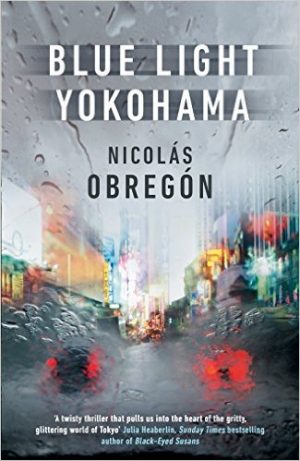 Written by Nicolas Obregon – What an entertaining debut! Told almost exclusively from the perspective of Tokyo Metropolitan Police Department Inspector Kosuke Iwata, it’s a multilayered police procedural involving murder, official corruption, and dangerous secrets.
Written by Nicolas Obregon – What an entertaining debut! Told almost exclusively from the perspective of Tokyo Metropolitan Police Department Inspector Kosuke Iwata, it’s a multilayered police procedural involving murder, official corruption, and dangerous secrets.
A brief prologue set in 1996 describes the death of a woman who jumped from a dangling cable car into the sea, despite the efforts of police detective Hideo Akashi to save her. Fifteen years later, Akashi – now a prominent Tokyo police detective – is investigating the quadruple murder of a Korean family. In the midst of his investigation, he commits suicide by jumping off Tokyo’s Rainbow Bridge. No-one knows why. The theme of falling pervades the novel and ties together many of its strands, past and present.
The brass at the police department asks its newest detective, US-trained (and therefore highly suspect) Iwata to pick up where Akashi left off. Iwata is aided by Assistant Inspector Sakai, transferred from the Missing Persons department to work with him. These two inexperienced homicide detectives are assigned such a major murder case because the department is short-handed, having lost Akashi, and is focused instead on another of his cases, the mysterious death of high-profile actress Mina Fong. A little racism creeps in, as well; as Iwata’s supervisor explains: “The family were Korean, so not exactly front-page news.”
Iwata and Sakai manage to get along rather well, considering. He is battling major demons from the present and the past, which began when his mother abandoned him in a bus station, leaving him to spend most of his childhood in an orphanage. He is haunted by his memories of those days, and the significance of his background is only gradually revealed.
Working against stereotype, Sakai is a feisty young woman whose reflexive prickliness provides a lively counterpoint of humour. At the end of an interview with the leader of a reviled super-nationalist political group, for example, she says:
‘Mr. Onaga, I hope we cross paths again. I do.’
Smiling, Onaga stood and offered his hand. ‘Oh yes, Inspector. It was a pleasure.’
‘No, I think you misunderstand my meaning.’”
Not what you want to hear from a homicide detective!
Although the deaths of each member of the Korean family were gruesome, the most striking was that of the father, who seemed to be the killer’s principal target. Not only was his heart removed, on the ceiling over his body was an ominous charcoal drawing of a black sun the man himself made shortly before his death.
Iwata and Sakai are having difficulty getting traction in their investigation when the lonely widow of a judge is murdered. Again, her heart has been removed, and there’s a huge black sun drawn with her dead husband’s ashes.
Sakai and Iwata are anxious to understand what the link might be between these crimes, because, until they do, they can’t try to prevent any additional murders. They pursue multiple lines of inquiry, all of them interesting, and most going nowhere. Iwata exceeds his authority and travels to Hong Kong to gather information about the death of the glamorous Mina Fong’s less glamorous older sister, a presumed suicide.
The author has lived in Japan and seems to be a Japanophile. Not only does he describe the physical settings and social climates of Tokyo, Kyoto, and Hong Kong with precision, but he also carefully explores Iwata’s complex interior life and motivations. The atmosphere he creates is therefore dense with possibilities. One of them is that not everyone on the police force is hoping he and Sakai succeed.
A dozen or so poetic lines repeatedly float through Iwata’s mind: “The lights of the city are so pretty; I walk and walk, swaying, like a small boat in your arms.”
You won’t learn the origins of the lines until well along, and ultimately they are the source of the book’s title. But Obregon is a more subtle writer than that, and the title also echoes an effort to prevent suicides by installing blue lights on Tokyo train station platforms. The colour blue is supposedly calming. The flashing blue of police cars, another recurrent image Obregon, would belie that assumption.
The Japanese names may take some getting used to. It’s helpful to be able to flip back and re-establish who a few of the characters are, but in general, this isn’t a problem. If you enjoy an immersive police procedural with an exotic setting, like these other notable books from Japan, you’ll love Blue Light Yokohama.
Penguin
Print/iBook/Kindle
£9.49
CFL Rating: 5 Stars








